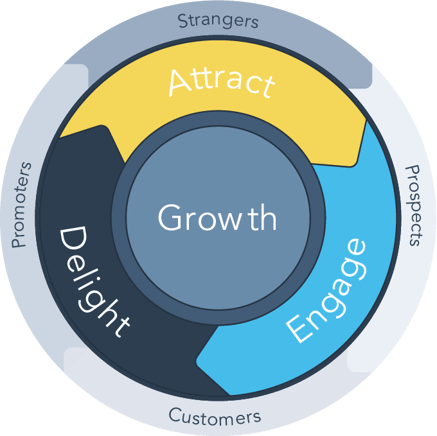Are you tired of traditional marketing methods that seem to reach everyone but your target audience? Do you want to focus your efforts on high-value accounts and increase your ROI? If so, you may want to consider account-based marketing (ABM).
According to recent research, companies that align their account-based marketing strategies see an increase of 208%.
ABM has been gaining popularity in recent years, especially among B2B companies. It involves identifying and targeting specific accounts, rather than casting a wide net and hoping for the best.
But what exactly is account-based marketing, and how does it work?
In this article, we'll explore the basics of ABM, including its benefits, challenges, and best practices. Whether you're a marketer or a business owner, understanding ABM can help you take your marketing efforts to the next level and achieve better results.
|
Account-Based Marketing Account-based marketing (ABM) is a focused growth strategy in which Marketing and Sales collaborate to create personalized buying experiences for a mutually-identified set of high-value accounts. |
What is Account-Based Marketing?
Account-Based Marketing (ABM) is a strategic marketing approach that focuses on targeting specific high-value accounts rather than casting a wide net to a broader audience.
In ABM, you tailor your messaging and content to resonate with key decision-makers within these target accounts, aiming to establish personalized and meaningful connections.
Unlike traditional marketing approaches that primarily rely on mass communication and lead generation, ABM flips the script by prioritizing quality over quantity. By identifying and prioritizing key accounts, marketers can deliver customized experiences and build strong relationships that drive higher conversion rates and revenue growth.
At the core of ABM lies the concept of treating each account as a market of one. Rather than employing a generic marketing strategy, ABM allows marketers to understand the unique needs, pain points, and preferences of each target account.
By gathering insights through research and data analysis, you can create highly personalized campaigns and content that resonate with decision-makers and stakeholders.
ABM is particularly effective in B2B (business-to-business) industries where the sales cycle is typically longer and involves multiple stakeholders.
How ABM Differs from Traditional Marketing Approaches
Traditional marketing approaches often focus on casting a wide net, targeting a large audience, and generating leads through mass communication channels such as advertising, content marketing, and lead-generation campaigns. The goal is to attract as many potential customers as possible, hoping that some will convert into paying customers.
ABM, on the other hand, takes a more targeted and account-specific approach. Instead of trying to reach a broad audience, ABM narrows the focus to a select group of high-value accounts. The goal is to establish meaningful connections with decision-makers and influencers within those accounts, tailoring marketing efforts to their specific needs and pain points.
While traditional marketing strategies may rely on reaching a high volume of leads, ABM prioritizes quality over quantity.
By identifying and focusing on key accounts that have a higher likelihood of converting into customers, marketers can allocate their resources more effectively, resulting in better conversion rates and a higher return on investment (ROI).
The Role of Personalization and Targeting in ABM
Personalization and targeting are fundamental elements of ABM. The ability to deliver highly relevant and tailored experiences to key decision-makers within target accounts sets ABM apart from other marketing strategies.
By leveraging data, market research, and account-specific insights, marketers can craft personalized messaging, content, and offers that resonate with the needs and pain points of each account. This level of personalization not only captures the attention of decision-makers but also establishes credibility and builds trust.
Personalization in ABM goes beyond simply addressing the recipient by name. It involves understanding the account's industry, challenges, goals, and preferences, and creating content that directly addresses those factors.
This could include customizing email campaigns, creating personalized landing pages, or developing targeted advertising campaigns specific to the account's needs.
The role of targeting in ABM is equally important. Instead of spreading marketing efforts across a broad audience, ABM allows marketers to focus on accounts that align with their ideal customer profile. By using criteria such as industry, company size, revenue, or specific attributes that indicate a higher propensity to purchase, marketers can identify accounts with the greatest potential for conversion and revenue generation.
Account-Based Marketing and Inbound Marketing
Account-Based Marketing (ABM) and Inbound Marketing are powerful strategies that, when combined, create a comprehensive and effective marketing approach.
Inbound Marketing helps attract target accounts, while ABM accelerates the flywheel by winning and delighting those accounts with a remarkable customer experience.

By leveraging Inbound Marketing as the foundation, ABM allows for targeted and efficient resource allocation toward high-value accounts. This combined approach broadens the prospect pool compared to using just one method.
Additionally, the content created has a two-for-one value, serving both ABM and Inbound strategies. For example, a personalized case study for a target account can also be shared on your website.
To facilitate the implementation of this combined strategy, software tools like HubSpot's account-based marketing tool exist, making it easy to align and execute ABM and Inbound strategies seamlessly.
By integrating the strengths of ABM and Inbound Marketing, you can attract a broader range of prospects, allocate resources effectively, and create content with dual purposes. This approach enables you to deliver exceptional customer experiences and maximize your marketing efforts.
Examples of Industries and Businesses that Benefit from ABM
Account-Based Marketing has proven to be highly effective across various industries, particularly in B2B sectors with complex sales cycles and high-value accounts.
Here are a few examples of industries and businesses that benefit from ABM:
1. Technology
In the technology sector, where products and services are often targeted towards specific industries or niches, ABM helps marketers focus their efforts on key accounts within those industries.
This enables them to create targeted campaigns and messaging that highlight the unique value proposition for each account.
2. Finance
Financial institutions, including banks, investment firms, and insurance companies, often have a select group of high-value clients they aim to retain and expand relationships with.
ABM allows marketers in the finance industry to deliver personalized experiences that cater to the unique financial needs and goals of these key accounts.
3. Healthcare
Healthcare providers, pharmaceutical companies, and medical device manufacturers can benefit from ABM by targeting specific hospitals, healthcare systems, or medical professionals.
ABM enables marketers in the healthcare industry to customize messaging and content that address the challenges and compliance requirements of their target accounts.
4. Manufacturing
Manufacturers often have a limited number of key accounts that contribute to a significant portion of their revenue.
ABM enables marketers in the manufacturing sector to build strong relationships with these key accounts, understand their specific needs, and provide tailored solutions that drive long-term partnerships.
These examples highlight the versatility of ABM across industries and the potential impact it can have on revenue growth and customer retention. By focusing on high-value accounts and delivering personalized experiences, businesses can forge deeper connections, drive conversions, and gain a competitive edge in their respective markets.
The Key Benefits of ABM
Implementing an effective Account-Based Marketing (ABM) strategy offers numerous benefits for you to maximize your marketing efforts. Here are some of the key benefits of ABM:
1. Increased ROI and Revenue Growth
One of the primary benefits of ABM is its ability to drive higher returns on investment (ROI) and revenue growth. By targeting high-value accounts that align with the ideal customer profile, ABM allows you to focus your resources on prospects that have a higher likelihood of converting into customers.
The laser-focused approach of ABM results in improved conversion rates. According to research conducted by the Alterra Group, 97% of marketers stated that ABM had a somewhat higher or much higher ROI compared to other marketing initiatives.
By allocating resources strategically and delivering personalized messaging and content, you can increase their chances of capturing the attention and interest of key decision-makers within their target accounts.
2. Enhanced Customer Satisfaction and Loyalty
ABM enables you to create tailored experiences for target accounts, fostering stronger connections and deeper relationships.
By delivering personalized content that speaks directly to the unique needs and challenges of each account, you can demonstrate a thorough understanding of your customers and position your business as a trusted partner rather than a mere vendor.
This level of personalization not only enhances customer satisfaction but also drives customer loyalty. According to Alterra Group, 84% of businesses indicated that ABM significantly improved customer retention and loyalty.
3. Improved Alignment Between Marketing and Sales Teams
A key advantage of ABM is the improved alignment it fosters between marketing and sales teams.
According to a study by SiriusDecisions, organizations with tightly aligned sales and marketing functions experience 24% faster revenue growth and 27% faster profit growth over three years.
In traditional marketing approaches, there is often a disconnect between marketing-generated leads and the sales team responsible for converting those leads into customers. This misalignment can lead to wasted resources, inefficiencies, and missed opportunities.
ABM addresses this challenge by encouraging collaboration and shared goals between marketing and sales teams. By adopting an account-centric approach, both teams are incentivized to work together throughout the buyer's journey, supporting each other's efforts and leveraging shared insights.
The alignment between marketing and sales teams leads to improved communication, resulting in clearer handoffs as leads progress through the sales funnel. Marketing can provide valuable information and insights about each account's preferences, pain points, and engagement history, enabling sales teams to have more meaningful conversations and tailor their approach accordingly.
The ABM Process: Step-by-Step Guide
Implementing Account-Based Marketing (ABM) requires a structured approach that encompasses various stages. Let's explore the step-by-step process to guide you through a successful ABM implementation:
1. Identifying and Selecting Target Accounts
The first step in the ABM process is identifying and selecting the target accounts that align with your ideal customer profile. Consider the following criteria when choosing your target accounts:
-
Revenue Potential: Look for accounts that have the potential to generate significant revenue and contribute to long-term partnerships. Consider their size, industry influence, and purchasing power.
-
Fit with Ideal Customer Profile: Ensure that the target accounts match your ideal customer profile. Consider their industry, pain points, challenges, and alignment with your product or service offerings.
-
Strategic Importance: Identify accounts that align with your strategic goals and objectives. This may include targeting specific industries, geographic regions, or key players in the market.
Leverage data and analytics to identify potential target accounts. Consider using firmographic data, technographic data, and behavioral data to gain insights into the characteristics and preferences of your target accounts.
2. Developing Personalized Messaging and Content
Once you have identified your target accounts, it's crucial to develop personalized messaging and content that resonates with each account. Consider the following steps:
-
Account Research: Conduct in-depth research on each target account to understand their industry, challenges, objectives, and key stakeholders. This research will provide valuable insights that can be used to tailor your messaging.
-
Value Proposition: Craft a compelling value proposition that highlights the unique benefits and solutions your product or service offers to each target account. Emphasize how your offerings address their specific pain points and contribute to their success.
-
Content Creation: Develop content that aligns with the needs and preferences of each account. This may include blog posts, case studies, whitepapers, videos, or customized landing pages. Ensure that the content addresses their industry-specific challenges and provides valuable insights.
3. Executing Targeted Campaigns and Tactics
With personalized messaging and content in place, it's time to execute targeted campaigns and tactics to engage your target accounts effectively. Consider the following strategies:
-
Channel Selection: Choose the most appropriate communication channels to reach your target accounts. This may include email marketing, social media advertising, personalized direct mail, or account-specific events. Align the channels with the preferences and behavior of each account.
-
Automation and Technology: Leverage automation tools and technology to scale your ABM efforts efficiently. This may involve using customer relationship management (CRM) software, marketing automation platforms, or account-based advertising tools to streamline your campaigns and track engagement.
4. Measuring and Evaluating ABM Effectiveness
To ensure the success of your ABM efforts, it's essential to measure and evaluate their effectiveness. Consider the following steps:
-
Key Performance Indicators (KPIs): Define relevant KPIs to track the success of your ABM campaigns. These may include metrics such as conversion rates, revenue generated, pipeline acceleration, customer retention, and account engagement.
-
Tracking and Analysis: Use analytics tools and reporting systems to track the performance of your ABM campaigns. Monitor key metrics and gather insights into the engagement levels, conversions, and revenue generated from your target accounts.
-
Iterative Improvement: Continuously optimize and refine your ABM strategies based on the insights and data collected. Identify areas for improvement, experiment with different tactics, and iterate on your messaging and content to enhance the effectiveness of your ABM efforts.
By following this step-by-step guide, you can effectively implement Account-Based Marketing and drive meaningful results for your business.
Overcoming Challenges in Implementing ABM
While Account-Based Marketing (ABM) offers significant benefits, its implementation can come with its fair share of challenges. Understanding and addressing these challenges is crucial for a successful ABM strategy.
Let's explore some common hurdles and strategies for overcoming them:
1. Alignment Between Marketing and Sales Teams
Challenge: One of the primary challenges in ABM implementation is achieving alignment between marketing and sales teams. Misalignment can result in disjointed efforts, conflicting strategies, and a lack of collaboration, leading to suboptimal results.
Strategy: To overcome this challenge, foster open communication and collaboration between marketing and sales teams. Encourage regular meetings and shared goal-setting sessions to align strategies and objectives.
Establish a feedback loop to exchange insights and improve coordination throughout the ABM process. Also, consider implementing a shared platform or CRM system that allows both teams to access and update account information, ensuring a seamless handoff from marketing to sales.
2. Data Management and Integration
Challenge: ABM relies on accurate and comprehensive data to identify target accounts, personalize messaging, and measure campaign effectiveness. The challenge lies in managing and integrating disparate data sources, ensuring data quality, and leveraging insights effectively.
Strategy: Invest in robust data management systems and tools that enable data consolidation, cleansing, and integration. Implement data governance practices to maintain data quality and accuracy.
Leverage customer relationship management (CRM) platforms, marketing automation tools, and data analytics solutions to gather and analyze data effectively. Regularly assess and update your data sources to ensure they align with your ABM objectives.
3. Scaling ABM Efforts for Larger Organizations
Challenge: Scaling ABM efforts can be challenging for larger organizations with a vast number of accounts and diverse target segments. Ensuring consistency, personalization, and efficient execution across a large-scale ABM program requires careful planning and resource allocation.
Strategy: Adopt a tiered approach to ABM, where you prioritize accounts based on their revenue potential and strategic importance. Segment your target accounts into different tiers and allocate resources accordingly.
Leverage automation tools and technologies to streamline processes, personalize at scale, and manage large-scale ABM campaigns efficiently. Implement account-based advertising and content syndication strategies to extend your reach and engagement with target accounts.
4. Keeping Up with Evolving Technology and Trends
Challenge: ABM is influenced by evolving technology and market trends. Staying abreast of the latest advancements, tools, and techniques can be a challenge, but it's essential to maintain a competitive edge and ensure the effectiveness of your ABM strategies.
Strategy: Develop a culture of continuous learning and adaptability within your marketing team. Stay informed about emerging ABM technologies, trends, and best practices through industry publications, conferences, webinars, and networking events.
Foster partnerships with technology providers and consultancies (like us at Fine Media) specializing in ABM to leverage their expertise and stay at the forefront of ABM innovation. Regularly evaluate your ABM strategies and adjust them to align with evolving market dynamics.
By addressing these challenges head-on and implementing the suggested strategies, you can navigate the complexities of ABM implementation and maximize the impact of your ABM efforts.
Best Practices and Tips for Successful ABM Implementation
Implementing Account-Based Marketing (ABM) requires careful planning, execution, and continuous optimization. To ensure the success of your ABM strategy, consider the following best practices and tips:
1. Building a Solid Foundation with Account Research and Insights
-
Thoroughly Research Target Accounts: Conduct comprehensive research on each target account to understand their industry, challenges, goals, and key decision-makers. Gather insights through online research, industry reports, social media, and networking.
-
Identify Pain Points and Objectives: Identify the pain points, objectives, and priorities of each target account. Tailor your messaging and content to address these specific needs, positioning your product or service as a solution.
-
Engage with Key Stakeholders: Build relationships with key stakeholders within the target accounts. Engage in meaningful conversations, attend industry events, and leverage social selling techniques to establish rapport and understand their perspectives.
2. Establishing Effective Communication and Collaboration Channels
-
Facilitate Communication Between Marketing and Sales: Foster regular communication and collaboration between marketing and sales teams. Schedule joint meetings, share insights and feedback, and align strategies and goals to ensure a cohesive ABM approach.
-
Use CRM and Collaboration Tools: Implement a customer relationship management (CRM) system and collaboration tools to centralize account information, track interactions, and share updates between teams. This promotes transparency, accountability, and efficient coordination.
-
Leverage Sales Enablement Resources: Provide sales teams with the necessary resources, such as tailored content, battle cards, and playbooks, to effectively engage with target accounts. Enable them to have informed conversations and address account-specific pain points.
3. Integrating ABM into the Overall Marketing Strategy
-
Align ABM with Business Objectives: Ensure that your ABM strategy aligns with your overall business objectives and marketing goals. ABM should complement and enhance your existing marketing efforts, rather than operate in isolation.
-
Segmentation and Personalization: Segment your target accounts based on specific criteria, such as industry, revenue potential, or pain points. Develop personalized messaging and content for each segment to deliver relevant experiences and drive engagement.
-
Integrate ABM with Other Marketing Channels: Combine ABM tactics with other marketing channels, such as content marketing, social media, and email marketing, to create a cohesive and omnichannel approach. Consistency across channels enhances brand perception and engagement.
4. Continuous Optimization and Improvement through Testing and Iteration
-
Track and Analyze Performance Metrics: Establish key performance indicators (KPIs) to measure the success of your ABM campaigns. Track metrics such as conversion rates, pipeline acceleration, revenue generated, and account engagement to evaluate the effectiveness of your strategies.
-
Experiment and Test: Continuously experiment with different messaging, content formats, channels, and tactics to identify what resonates best with your target accounts. A/B tests different variations to optimize your campaigns and improve results.
-
Iterate and Refine: Regularly review and refine your ABM strategies based on insights gained from data analysis and feedback. Identify areas for improvement, adjust your messaging and tactics, and iterate on your approach to achieve better outcomes.
By following these best practices and implementing these tips, you can enhance the effectiveness of your ABM implementation and drive meaningful results for your business.
Build an ABM Strategy
Account-Based Marketing (ABM) is a powerful strategy that allows you to engage with your most valuable target accounts and drive meaningful results.
In conclusion, Account-Based Marketing (ABM) offers a powerful marketing approach that can drive higher ROI, enhanced customer satisfaction, and improved alignment between marketing and sales teams. By targeting high-value accounts, personalizing messaging, and fostering collaboration, businesses can unlock the full potential of ABM.
To build an effective ABM strategy, it is crucial to understand the fundamentals of ABM, overcome implementation challenges, and follow best practices. Integrating ABM with your existing Inbound Marketing efforts can further amplify your results, attracting a broader range of prospects and optimizing resource allocation.
As you embark on your ABM journey, consider partnering with a HubSpot Partner Agency like Fine Media. Our experienced team understands the intricacies of ABM and can guide you through the process, from developing a robust strategy to executing targeted campaigns.
With Fine Media's expertise, you can leverage the power of ABM to drive remarkable results and achieve your marketing goals.
Contact us today to discover how we can help you achieve remarkable results.



